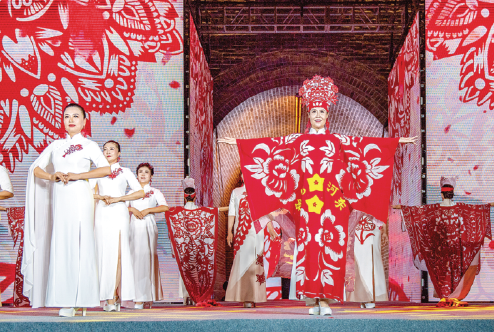Traditions and craftsmanship kept alive through millennia
Updated: 2022-09-16

A fashion show featuring traditional cultural elements is staged in the city of Yuncheng. [Photo by Li Lianjun for China Daily]
Porcelain, ink slabs and lacquerware showcase Shanxi's cultural excellence
As a cradle of Chinese civilization, Shanxi province's brilliant culture that accumulated over millennia is a source of pride and inspiration for residents.
With this cultural heritage kept alive, locals are using these precious assets to improve their livelihoods and enhance their sense of happiness and gain.
The province's cultural assets are represented by the time-honored production techniques of fahua porcelain ware, chengni ink slabs and hand-polished lacquerware. They are known as the "three treasures of Shanxi".
The county of Xinjiang, which was called Jiangzhou in ancient times, for instance, is famous for chengni ink slab. It is one of the top four ink slabs in China, alongside duan in Zhaoqing, Guangdong province; she in Shexian, Anhui province; and taohe in Zhuoni county, Gansu province.
Unlike other ink slabs, which are made from natural stone, chengni ink slab is produced by firing silt-rich clay collected from local riverbeds. The product features elegant shapes and delicate engravings, which make them valuable pieces of art.
Xinjiang county is now home to the Jiangzhou Chengni Ink Slab Cultural Industry Park, which was designed to develop an industrial chain centered around the production of chengni ink slabs. It aims to protect the 2,000-year-old technique and make it an industrial pillar to boost the local economy and residents' incomes.
Lin Tao, who was recently granted the honor of "China's artifact master", and his father Lin Yongmao, have made a special contribution to reviving and developing this ancient technique.
The technique for making the clay-fired ink slab is said to date back to the Han Dynasty (206 BC-AD 220). The craft was lost during the Qing Dynasty (1644-1911).
The father and son decided to revive the ancient technique in 1986. They visited many libraries to read historical documents and museums to study exhibits.
After much trial and error, they succeeded in making three chengni ink slabs in 1991. In 1994, their ink slabs won a gold prize at the China Expo of Famous Ink Slabs.
"I have been in this trade for 36 years," Lin Tao said. "As I was excited to see the revival of this lost artwork decades ago, I'm now happy that we have engaged more people in the trade to pass on this valuable art to the future generations."
He said he is also glad to see chengni ink slab developing into a local specialty industry, bringing tangible benefits to local residents.
The county of Pingyao is a witness to the revitalization of the craft of hand-polished lacquerware.
Pingyao's lacquerware, especially the hand-polished-or tuiguang-variety, is a brilliant representative of the millennia-long craft in China.
Tuiguang lacquerware of Pingyao is made of a natural raw lacquer unique to China and varnished by hand using a special technique.
In 2006, the technique for making Pingyao's tuiguang lacquerware was included in the national list of intangible cultural heritage.
Xue Xiaodong, an inheritor of the tuiguang lacquerware technique, highlights innovation in protecting and developing this time-honored technique, when it comes to growing it into a modern industry to benefit local economy and residents.
"Only by combining ancient aesthetics and the tastes of modern people, and integrating traditional skills with innovative ideas, can this precious art form sustain its vigor and vitality," Xue said.
Pingyao is now home to more than 150 businesses involved in the production of tuiguang lacquerware. By selling products across China and to about 30 foreign countries and regions, the industry has achieved a combined annual revenue of more than 500 million yuan ($71.8 million) in recent years.
Shanxi has enhanced its protection of intangible cultural assets over recent years. Fourteen heritage items in Shanxi were recently included in the latest national list for intangible cultural heritage protection.
Local heritage protection researchers and workers are using the latest technologies to protect cultural assets. Their efforts include an intangible cultural heritage database in the city of Jinzhong, digital showrooms at the Shanxi Museum in the provincial capital of Taiyuan and dozens of digital experience facilities in other cities and the countryside.
As Shanxi is one of the provinces with the largest number of tangible cultural assets, the province has adopted a similar high-tech approach to protecting its historical and cultural sites and relics.
The famed Yungang Grottoes in the northern Shanxi city of Taiyuan, for instance, has launched massive digitalization projects for relics' protection and exhibition.
"As one of the three most famous Buddhist cave art sites in China, Yungang Grottoes is now gaining worldwide attention thanks to the use of digital technologies," said Cui Xiaoxia, an official at the Yungang Grottoes Academy, an institution in charge of the site's protection and promotion.
The academy has launched an online platform for the display of relics, giving audiences at home and abroad an opportunity to see these cultural wonders up close.
Another effort of the academy is duplicating relics with 3D technology.
"The full-sized replicas, with a high level of resemblance, have been exhibited in a number of cities and regions in China," Cui said, adding that it is possible for the exhibits to be shown overseas in the future.
Based on traditional culture, Shanxi has developed modern forms of art. On stage, there are fashion shows incorporating traditional cultural elements, drama shows featuring modern themes and art festivals reaching the grassroots.
A testimony to Shanxi's flourishing modern culture is that local writers garnered more than 100 awards at home and abroad for their literature in 2021.
Sun Rui contributed to this story.



